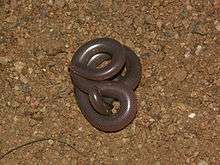Rhinotyphlops
Rhinotyphlops is a genus of blind snakes found in Africa, the Middle East and India.[1][2] Some species have been moved to Afrotyphlops and Letheobia.
| Rhinotyphlops | |
|---|---|
 | |
| Rhinotyphlops lalandei | |
| Scientific classification | |
| Kingdom: | Animalia |
| Phylum: | Chordata |
| Class: | Reptilia |
| Order: | Squamata |
| Suborder: | Serpentes |
| Family: | Typhlopidae |
| Subfamily: | Afrotyphlopinae |
| Genus: | Rhinotyphlops Fitzinger, 1843 |
| Synonyms[1] | |
| |
Species
| Species[2] | Taxon author[2] | Subsp.*[2] | Common name |
|---|---|---|---|
| R. ataeniatus | (Boulenger, 1912) | 0 | |
| R. boylei | (FitzSimons, 1932) | 0 | Boyle's beaked blind snake[3] |
| R. lalandeiT | (Schlegel, 1839) | 0 | Delalande's beaked blind snake[3] |
| R. leucocephalus | (Parker, 1930) | 0 | |
| R. schinzi | (Boettger, 1887) | 0 | Schinz's beaked blind snake[3] |
| R. scorteccii | (Gans & Laurent, 1965) | 0 | Scortecci's blind snake[4] |
| R. unitaeniatus | (W. Peters, 1878) | 0 | |
*) Not including the nominate subspecies.
T) Type species.[1]
gollark: OH BEE.
gollark: bee.
gollark: No.
gollark: ösmarks.tk
gollark: =bump
References
- McDiarmid RW, Campbell JA, Touré TA (1999). Snake Species of the World: A Taxonomic and Geographic Reference, Volume 1. Washington, District of Columbia: Herpetologists' League. 511 pp. ISBN 1-893777-00-6 (series). ISBN 1-893777-01-4 (volume).
- "Rhinotyphlops". Integrated Taxonomic Information System. Retrieved 29 August 2007.
- Branch, Bill (2004). Field Guide to Snakes and other Reptiles of Southern Africa. Third Revised edition, Second impression. Sanibel Island, Florida: Ralph Curtis Books. 399 pp. ISBN 0-88359-042-5. (Rhinotyphlops, pp. 53-54).
- "Rhinotyphlops scorteccii ". The Reptile Database. www.reptile-database.org.
External links
- Rhinotyphlops at the Reptarium.cz Reptile Database. Accessed 29 August 2007.
This article is issued from Wikipedia. The text is licensed under Creative Commons - Attribution - Sharealike. Additional terms may apply for the media files.